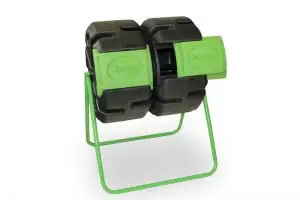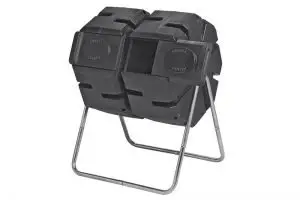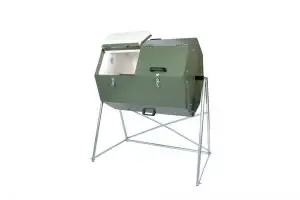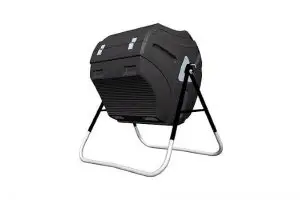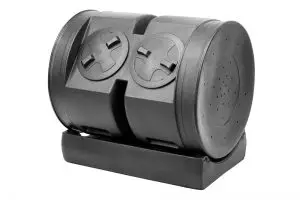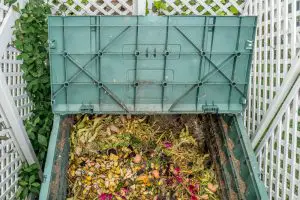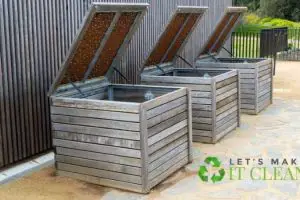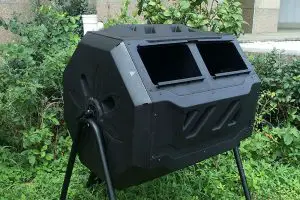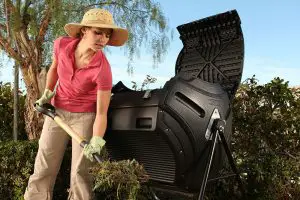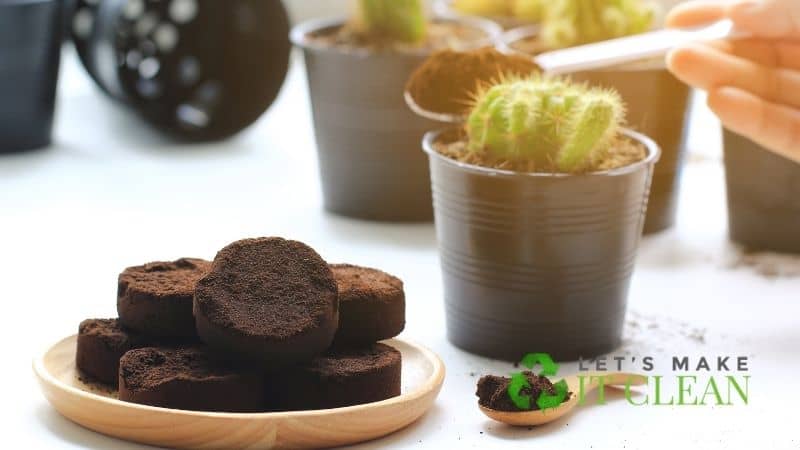Are you lost on whether you should put moldy food in your compost? Worry no more. In this comprehensive guide, we have all the answers regarding the food in composting and the best methods to use it.
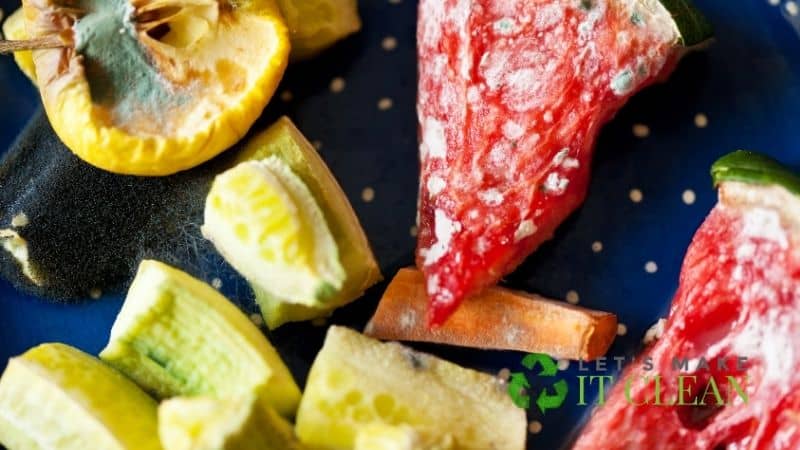
Having a compost pile or compost bin is an excellent way of recycling food scraps and other wastes in your home. If the waste ends up in landfills, it may produce harmful gases to the environment.
Quick Navigation
You can use almost every waste in the compost pile or compost bin, including grass clippings, banana peels, shredded newspaper, dry leaves, kitchen scraps, bread, tea bags, among other ingredients.
The goal is to end up with healthy compost that will aid soil conditioning and plant growth.
The ingredients you choose should also facilitate the composting process instead of slowing it down. They should not be harmful and should not lead to smelly compost.
So, is mold an appropriate ingredient to use in a compost pile or compost bin? Can they have harmful effects on the microorganisms involved in composting?
Is It Ok to Put Moldy Food in a Compost Pile?
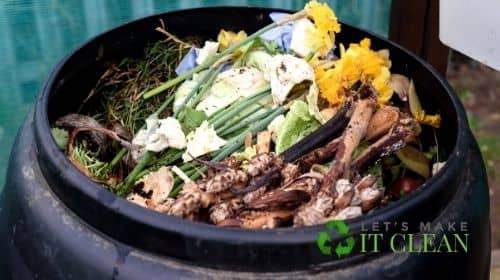
Yes, you can. You can add moldy fruits and vegetables to your compost pile in the backyard.
The decomposition process, either in a compost heap or compost bin, results from microorganisms that act on the organic matter and break down. The microorganisms include aerobic and anaerobic bacteria.
The aerobic bacteria act on organic matter such as kitchen waste, bread, and other food scraps when there is enough oxygen. When the aerobic organisms are active, the compost heap or worm bins don’t become smelly.
Alternatively, when the compost heaps or worm bins are not well aerated, the aerobic microbes cease to function. The anaerobic bacteria (that don’t require oxygen) take over, leading to a bad smell.
So, why is moldy food fit for use in worm bins or a compost heap?
Mold cells are organisms involved in breaking down organic matter, such as food waste, into useful nutrients that you can add to the soil for conditioning and plant growth.
When you add the food to compost, you add ingredients that are already decomposing to the heap. Fresh or moldy food in worm bins offers the necessary food supply for the worms.
Whether you use fresh or moldy food in compost piles, you’ll end up with healthy compost that is useful in your garden.
Is Mold Bad for Worm Compost?
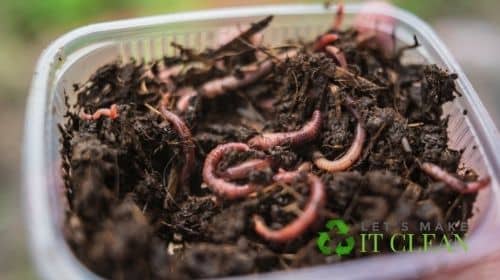
The worm composting process is a form of composting that involves worms recycling and decomposing organic matter such as food waste, coffee grounds, fruits, and vegetables.
The worms eat the organic materials that pass through their digestive system, where they are digested and then released as worm castings. Worm castings are nutritious components that are vital in soil conditioning.
Many people choose to have a worm bin at home to keep either indoors or outdoors.
Can you have moldy food in your worm bin?
Nothing stops you from putting moldy food in your worm bin. Just like fresh food items, moldy food waste makes food for the red wigglers. However, it would help if you made sure you don’t have harmful molds in the worm compost bins.
Some molds that form in low temperatures, like in the refrigerator, form some weak antibiotic compounds. The mold cells in the moldy foods use antibiotic compounds to keep other microorganisms away from their food.
If the worms eat the compounds, they kill some or all the essential microorganisms in the worm’s digestive system. This causes the worms to become sick and eventually die.
Molds found on moldy foods such as vegetables don’t have a problem. However, you should be careful with molds on some waste such as bread and some fruits as they can be problematic.
If you are not sure about how the worms will react to the moldy food, you can try out some small amounts and see if they will be bothered. If the worms are Ok, then you can go ahead and use the moldy food.
In case they are not, you can put the moldy food in the compost pile instead of the worm bin.
What if My Compost Gets Moldy?
Why does my compost have mold? This is a question that many gardeners, especially beginners, grapple with.
It is not unnatural to have molds growing on your compost.
As mentioned earlier, mold cells are like other microbes involved in decomposing waste into beneficial nutrients. Thus, you can get them in decomposing organic matter.
Mold on the dead matter is a sign of decomposition. Mold on your compost piles is not dangerous as long as it is mixed properly.
Some gardeners are also concerned by the color of moldy food in compost piles. Molds appear in different colors depending on the decomposition materials used in the composting piles. The colors can also vary depending on the climate and the location of the compost bin.
What do different moldy food colors signify?
Green is the most common color moldy food that you can find in your compost bins or piles. The green color signifies that your compost has large amounts of food waste, including vegetables, fruits, etc.
If you see pink color in your compost, it should be a red flag of things to look out for. The pink color of moldy food in your compost signifies the presence of cleaning products in a heap.
It will help if you get rid of such by avoiding using water with soap. The cleaning products can kill the microorganisms responsible for composting.
White color is not rare in compost heaps and bins. If you have while molds, it is a sign that the decomposition process is going on as it should. You’ll find white color on wood particles in your compost.
Types of Foods That Get Mold Fast
Some foods are more prone to developing molds than others. Such foods include rice, cereal foods, coffee grounds, bread, rotten fruits and vegetables, and spaghetti.
Why do the foods develop molds that fast?
First, when fruits and vegetables are close, ethylene gas accumulates, which attracts bacteria. The bacteria get into the products causing rot and developing mold.
Dry rice carries bacteria that can even survive cooking. The bacteria can cause the formation of mold in both cooked and dry rice.
When you open a cereal package, humidity from the air gets in, which encourages mold spores to develop.
Additionally, the moisture in watermelon and coffee grounds encourages bacteria to breed, which form mold.
The cooked tomato paste in spaghetti is low on acid. The moisture from the sauce combines with mold spores in the air to form mold.
Can the Mold Growth in My Compost Be Harmful to Me?
One of the many types of questions composters have is concerning their health.
Well, the mold in your pile won’t affect you by handling the compost during turning for aeration purposes. You should be safe as long as you don’t consume moldy food.
However, some people are sensitive to mold spores. If you are sensitive to the spores, you can use a mask every time you turn or deal with anything related to the compost. This ensures you don’t inhale the mold spores.
If your compost contains dairy products and meat, it can contain harmful bacteria and moldy food. The products can attract certain animals that can get sick if they eat food items.
Before you can put moldy food in the compost bin or pile, you should make sure it is the kind of food that is fit to put in the compost bins. This ensures you don’t have foods that would be harmful.
What Should You Not Put in Compost?
Do you have a tendency of throwing all the food scraps and waste into the compost?
Well, not all types of foods belong to the piles. Some types of food can cause damage to the pile.
Some of the ingredients to avoid in a compost include:
Coal Ashes
Some gardeners are tempted to add coal ashes in the compost to cover it. However, this is not the best idea as the ashes contain sulfur and iron, which can be harmful to the plants.
Chemical Pesticides
At no time you should NOT use materials with chemical residues in your compost. Some people can use grass trimmings, lawn trimmings, and vegetables that were sprayed. The chemical residues on the products can kill the microorganism responsible for the composting process.
Breakable Materials
Breakable materials such as metal and glass should never find their way into the compost. Apart from the fact that they cannot decompose, the materials are also problematic as they make it difficult for you to turn the compost for aeration.
Pet Waste
It will be of great help if you avoid pet waste in your compost bin or pile.
Pet waste from some animals such as cats and dogs can contain pathogens and viruses that can be harmful to the compost. The pathogens can also be a problem to the soil and plants later.
Meta and Dairy Products
It is recommended that you should never use meat and dairy products in your compost. First, the products are a major cause of bad smells in the compost. This makes it uncomfortable to have the compost bin, especially close to the house.
Apart from the bad smell, dairy products and meat are also popular for attracting pests, insects, and animals, disrupting the decomposition process.
How to Properly Add Moldy Food to Your Compost Bin
What steps do you follow when you want to add moldy food to your compost?
If you follow the right steps, you avoid bad smells and pests from your compost, and you also encourage decomposition to happen.
Step 1: Use a Food Processor to Blend the Moldy Food
Blending moldy food to mush is not mandatory, but it comes with a lot of benefits.
Blending the scraps helps the microorganisms or worms in the compost to digest the food faster. You can also add eggshells and coffee grounds at this stage.
Step 2: Add the Moldy Food to the Center of Your Compost
You shouldn’t add the moldy food just anywhere in the compost pile. It is recommended that you add it at the center of the pile and over dry and brown materials such as hay, grass clippings, or leaves.
Putting the moldy food at the center is helpful as it helps the mold to decompose faster due to the high temperatures.
Step 3: Cover the Moldy Food
As soon as you add the moldy food to the pile, it would be best to cover it using more dry and brown materials.
Step 4: Add Garden Soil or Aged Manure
This step is recommended for compost bins and not worm bins.
After covering the moldy food, you should add garden soil or aged manure. This process helps the food to decompose fast.
Step 5: Turn the Compost
It will help a lot if you turn the compost often to aerate it (see our aerator reviews). This helps to avoid bad smells and also speeds up the decomposition process.
Conclusion
If you were lost on whether you can use moldy food in compost and the best way to use it, this article has all the answers. We have the answers on why you need moldy food in your compost and what to avoid to make the compost safe.
We also have a guide on the best way to add moldy food to your compost to avoid bad smells and encourage decomposing.

